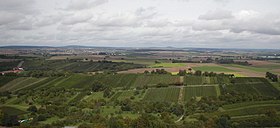|
Kraichgau     The Kraichgau (German: [ˈkʁaɪçɡaʊ] ⓘ) is a hilly region in Baden-Württemberg, southwestern Germany. It is bordered by the Odenwald and the Neckar to the North, the Black Forest to the South, and the Upper Rhine Plain to the West. To the east, its boundary is considered to be the Stromberg and the Heuchelberg. The largest towns of the Kraichgau are Sinsheim, Eppingen, and Bretten. On the western end of the Kraichgau is the town of Bruchsal, the gateway to the Rhineland plains. The mild climate and fertile soils allow for rural land use for orchards, vineyards and arable farming. In this region with full of nature you will find so many possibities of different activities. Kraichgau Fruit growing and viticulture characterize the region, and the fertile loess soil has always made it the breadbasket of southern Germany. Enz and Neckar valleys The course of the Neckar and Enz rivers meanders past cultural-historical sights and varied vegetation - partly characterised by steep vineyards, partly by gently rolling hills. Stromberg-Heuchelberg Nature Park Wine, forest and well-being. With wide views, gentle contours, closeness to nature, diverse changes and rare animal and plant species such as the wildcat. Zabergäu Germany's largest red wine landscape! The charming wine region of the Zabergäu is surrounded by the Stromberg and Heuchelberg mountain ranges. Origins of the nameThe word "Kraich" apparently arose from the Celtic word "Creuch," meaning "mud" or "loam." The territory of a Gau (country subdivision) signifies an open area, free from woods, such as farmland or meadows. The area of Kraichgau was first mentioned in the Early Middle Ages, in the Lorsch codex, as "Creichgowe" in the year 769. In 773, it was called "Chrehgauui," in 778 "Craichgoia." By 1594, the name was closer to its modern form, being referred to as "Kreuchgau." See also |
Portal di Ensiklopedia Dunia